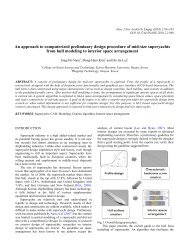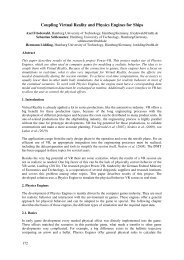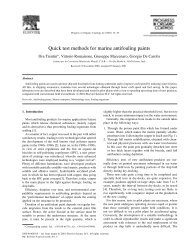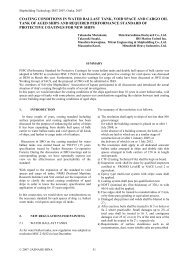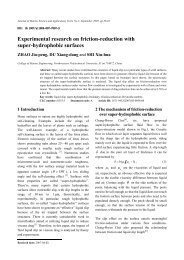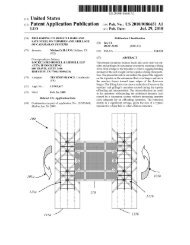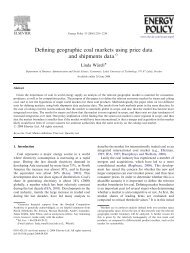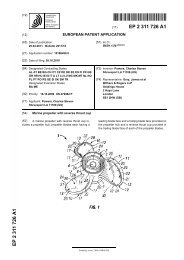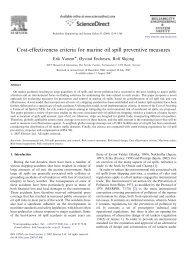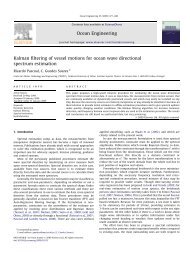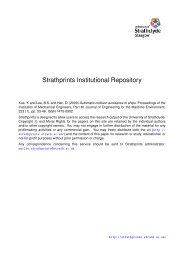Seakeeping standard series for oblique seas (a synopsis)
Seakeeping standard series for oblique seas (a synopsis)
Seakeeping standard series for oblique seas (a synopsis)
You also want an ePaper? Increase the reach of your titles
YUMPU automatically turns print PDFs into web optimized ePapers that Google loves.
Ocean Engineering 27 (2000) 111–126<br />
www.elsevier.com/locate/oceaneng<br />
<strong>Seakeeping</strong> <strong>standard</strong> <strong>series</strong> <strong>for</strong> <strong>oblique</strong> <strong>seas</strong><br />
(a <strong>synopsis</strong>)<br />
G.J. Grigoropoulos a,* , T.A. Loukakis a , A.N. Perakis b<br />
a National Technical University of Athens, 9 Heroon Polytechniou str., 15773 Zografos, Greece<br />
b University of Michigan, 48109-2145 Ann Arbor, Ann Arbor, MI, USA<br />
Abstract<br />
Received 27 April 1998; accepted 8 July 1998<br />
The seakeeping per<strong>for</strong>mance in <strong>oblique</strong> <strong>seas</strong> <strong>for</strong> a <strong>series</strong> of 72 cruiser-stern hull <strong>for</strong>ms has<br />
been evaluated analytically and is presented in a systematic way. The hull <strong>for</strong>m <strong>series</strong> have<br />
been created by Loukakis and Chryssostomidis (1975) by extending the principal characteristics<br />
of the Series 60 to cover usual shipbuilding practice. In that work, however, only the<br />
seakeeping per<strong>for</strong>mance in head <strong>seas</strong> was presented. Recently, the seakeeping per<strong>for</strong>mance of<br />
the Extended Series 60 was re-evaluated <strong>for</strong> both head <strong>seas</strong> and <strong>oblique</strong> <strong>seas</strong>. The complete<br />
results are presented in tabular and graphical <strong>for</strong>m as a function of the principal characteristics<br />
of the ship, the Froude number (including Fn 0, missing in the original <strong>series</strong>), the nondimensional<br />
modal wave period and the heading angle in a separate NTUA report<br />
(Grigoropoulos et al., 1994). In the present paper, the results <strong>for</strong> one case are given in tabular<br />
<strong>for</strong>m accompanied by graphical representation. They include: heave, pitch, bending moment<br />
amidships, added resistance, absolute vertical acceleration and relative vertical motion at the<br />
bow and the stern regions and relative vertical velocity at stations 2 and 4 where slamming<br />
is likely to occur. © 1999 Elsevier Science Ltd. All rights reserved.<br />
Keywords: <strong>Seakeeping</strong> responses; <strong>Seakeeping</strong> Standard Series; Series 60; Oblique <strong>seas</strong>; Strip theory; Vertical<br />
ship motions; Added resistance in waves<br />
Nomenclature<br />
A wave amplitude<br />
B beam<br />
* Corresponding author.<br />
0029-8018/00/$ - see front matter © 1999 Elsevier Science Ltd. All rights reserved.<br />
PII: S 00 29 -8018(98)00055-9
112 G.J. Grigoropoulos et al./Ocean Engineering 27 (2000) 111–126<br />
CB block coefficient<br />
Fn<br />
g<br />
Froude number, Fn Vs/√gLWL acceleration of gravity, 9.81 m/s2 H1/3 significant wave height (metres)<br />
Kyy longitudinal radius of gyration about LCG<br />
Kyy longitudinal radius of gyration of the <strong>for</strong>ward part of the ship about<br />
LCG F<br />
L, LBP length between perpendiculars<br />
LWL LCB<br />
length on design waterline, <strong>for</strong> the Extended Series 60 LBP 0.983<br />
LWL longitudinal position of centre of buoyancy<br />
LCF longitudinal position of centre of flotation<br />
LCG longitudinal position of centre of gravity<br />
LCG F<br />
distance of the centre of gravity of the <strong>for</strong>ebody from amidships<br />
RAO response amplitude operator<br />
RMS root-mean-square value<br />
RM amplitude of relative bow motion<br />
SSS <strong>Seakeeping</strong> Standard Series<br />
t thrust deduction factor<br />
T draft<br />
TP modal period<br />
TP VS non-dimensional modal period, TPTP/√L/g ship speed<br />
weight of <strong>for</strong>ward part of ship<br />
WF WT total weight of ship<br />
heading angle, 180° corresponds to head <strong>seas</strong><br />
pitch amplitude<br />
wave number<br />
wave length<br />
V<br />
RAO of bending moment, V (bending moment<br />
amplitude)/(gABL 2 )<br />
specific density of sea water<br />
aw<br />
RAO of added resistance, aw (mean added<br />
resistance)/[gA 2 (B 2 /L)]<br />
circular frequency<br />
1. Introduction<br />
The seakeeping per<strong>for</strong>mance of a ship can either be predicted using computer<br />
codes or measured in a seakeeping basin. However, during a feasibility study or in<br />
the preliminary ship design phase, the hull lines of the vessel are not yet available<br />
and, hence, neither of the a<strong>for</strong>ementioned methods is applicable. In an attempt to<br />
assist the naval architect in predicting the seakeeping behaviour in such cases, Loukakis<br />
and Chryssostomidis (1975) presented the <strong>Seakeeping</strong> Standard Series (SSS)
G.J. Grigoropoulos et al./Ocean Engineering 27 (2000) 111–126<br />
<strong>for</strong> cruiser-stern ships. In that work the authors extended the principal characteristics<br />
of the Series 60 to cover the usual shipbuilding practice and they computed the<br />
seakeeping per<strong>for</strong>mance of the resulting <strong>series</strong> analytically. Thus, they generated a<br />
set of tables containing the motion characteristics in head <strong>seas</strong> of 72 Extended Series<br />
60 hull <strong>for</strong>ms. The in<strong>for</strong>mation was given <strong>for</strong> a systematic variation of the principal<br />
ship geometric parameters, i.e. block coefficient C B, length-to-beam ratio L/B and<br />
beam-to-draft ratio B/T. The results were presented in tabular <strong>for</strong>m <strong>for</strong> various fully<br />
developed <strong>seas</strong>, expressed in terms of significant wave height to length ratio H 1/3/L BP<br />
and ship speed V S, expressed as non-dimensional Froude number Fn V S/√gL WL,<br />
where L WL is the length of the vessel at the design waterline.<br />
Since their presentation, the <strong>series</strong> have been extensively used in naval architecture<br />
practice as well as a teaching tool. The usefulness of the <strong>series</strong> has been appreciated,<br />
especially in studies on the effect of hull <strong>for</strong>m parameters on the seakeeping behaviour<br />
of ships. In this respect, the papers of Beukelman and Huijser (1977); Schmitke<br />
and Murdey (1980); Lee (1983); Pawlowski (1983); Loukakis et al. (1983); Grigoropoulos<br />
and Loukakis (1988, 1990); Wilson (1985) should be mentioned. Furthermore,<br />
Bhattacharyya (1978) included the <strong>series</strong> in his book on the dynamics of marine<br />
vehicles.<br />
Recently, Townsin et al. (1994) recognized the significance of the <strong>series</strong> and<br />
underlined their two strong points: the wide range of hull <strong>for</strong>ms and the number of<br />
the seakeeping responses calculated. However, it was pointed out that the seakeeping<br />
per<strong>for</strong>mance of the 72 hull <strong>for</strong>ms from the Extended Series 60 has been evaluated<br />
analytically only <strong>for</strong> head <strong>seas</strong>, while the H 1/3/L BP ratio range used, starting from<br />
H 1/3/L BP 0.015, corresponds to only relatively high sea states <strong>for</strong> the longer ships<br />
of today.<br />
The a<strong>for</strong>ementioned shortcomings of the <strong>series</strong> have also been noticed by the<br />
authors of the original paper. The inconvenient selection of the H 1/3/L BP ratios is<br />
closely connected to the use of single-parameter modelling of the sea state (fully<br />
developed <strong>seas</strong>), while the two-parameter spectral models are better representations<br />
of the actual sea conditions. Since the <strong>series</strong> refer to vertical motions only, which are<br />
linear with respect to the wave height, or to added resistance, which is proportional to<br />
the square of the wave height, these shortcomings could be remedied by appropriate<br />
scaling of the H 1/3 <strong>for</strong> the same modal period T P. However, it would be more convenient<br />
if the results were presented <strong>for</strong> a range of modal periods and <strong>for</strong> unity<br />
significant wave height.<br />
In addition, the absence of the zero-speed responses from the seakeeping tables<br />
prevented the use of the <strong>series</strong> in some applications, e.g. the design of stationary shipfactories<br />
or storage ships. Finally, scant usable in<strong>for</strong>mation exists in the literature <strong>for</strong><br />
ship responses in <strong>oblique</strong> <strong>seas</strong>, although such knowledge can be useful <strong>for</strong> ship<br />
routing and seakeeping operability studies.<br />
With the above in mind, it was decided to re-evaluate the seakeeping per<strong>for</strong>mance<br />
of the Extended Series 60 <strong>for</strong> all headings, using the same seakeeping responses as<br />
the initial paper and including a wider range of non-dimensional sea states as well<br />
as zero-speed responses. The strip theory of Salvesen et al. (1970) has again been<br />
used <strong>for</strong> the estimation of the ship motions and bending moments. The energy method<br />
113
114 G.J. Grigoropoulos et al./Ocean Engineering 27 (2000) 111–126<br />
of Gerritsma and Beukelman (1972), as extended by Loukakis and Sclavounos<br />
(1978), has been used <strong>for</strong> the prediction of added resistance in head to beam <strong>seas</strong>.<br />
The usage of the same theories <strong>for</strong> analytical predictions after some 23 years<br />
underlines the remarkable fact that the simple strip theory continues to give results<br />
useful <strong>for</strong> practical purposes in a computationally efficient manner and it has not<br />
been superseded by newer three-dimensional theories, except <strong>for</strong> the zero-speed case.<br />
In this respect, it is interesting to note that in two recent conferences (International<br />
Conference on High Speed Craft Motions and Manoeuvrability, 1998; International<br />
Conference on Ship Motions and Manoeuvrability, 1998) no fewer than eight authors<br />
were using strip theory <strong>for</strong> predictions in the absence of other tools, even at very<br />
high Fns! For a review of seakeeping theories and their applicability one can refer<br />
to Odabasi and Hearn (1978); Hearn and Donati (1981) and to the reports of the<br />
<strong>Seakeeping</strong> Committee of ITTC (15th ITTC <strong>Seakeeping</strong> Committee, 1978; 17th<br />
ITTC <strong>Seakeeping</strong> Committee, 1984; 20th ITTC <strong>Seakeeping</strong> Committee, 1993), where<br />
the usefulness of strip theory is generally recognized, at least <strong>for</strong> cruiser-stern ships<br />
sailing at zero to moderate speeds.<br />
In order to demonstrate the applicability of strip theory to <strong>oblique</strong> ship responses,<br />
the analytical results in regular waves have been compared to the experimental results<br />
conducted a long time ago at Wageningen (Vossers et al., 1960, 1961). Figs. 1–4<br />
show that <strong>for</strong> an L BP 120 m, C B 0.7, L/B 7, B/T 3.0 Series 60 hull <strong>for</strong>m,<br />
the predictions <strong>for</strong> pitching motion, relative bow motion, bending moment and added<br />
resistance can be used in practice, with the bending moment and the added resistance<br />
Fig. 1. Analytically estimated (Salvesen–Tuck–Faltinsen strip theory, Salvesen et al., 1970) and experimentally<br />
measured (Vossers et al., 1960) pitch RAO <strong>for</strong> a 120 m Series 60 ship with C B = 0.70, L/B =<br />
7.0 and B/T = 3.0 at Fn = 0.20.
G.J. Grigoropoulos et al./Ocean Engineering 27 (2000) 111–126<br />
Fig. 2. Analytically estimated (Salvesen–Tuck–Faltinsen strip theory, Salvesen et al., 1970) and experimentally<br />
measured (Vossers et al., 1960) relative bow motion RAO <strong>for</strong> a 120 m Series 60 ship with C B<br />
= 0.70, L/B = 7.0 and B/T = 3.0 at Fn = 0.20.<br />
Fig. 3. Analytically estimated (Salvesen–Tuck–Faltinsen strip theory, Salvesen et al., 1970) and experimentally<br />
measured (Vossers et al., 1960) bending moment RAO <strong>for</strong> a 120 m Series 60 ship with C B =<br />
0.70, L/B = 7.0 and B/T = 3.0 at Fn = 0.20.<br />
115
116 G.J. Grigoropoulos et al./Ocean Engineering 27 (2000) 111–126<br />
Fig. 4. Analytically estimated (Loukakis and Sclavounos, 1978) and experimentally derived (Vossers et<br />
al., 1960) added resistance RAO <strong>for</strong> a 120 m Series 60 ship with C B = 0.70, L/B = 7.0 and B/T = 3.0 at<br />
Fn = 0.20.<br />
results being the weaker predictions (in the case of added resistance, the measured<br />
added thrust is approximately converted to added resistance using the measured thrust<br />
deduction factor in calm water, t 0.184). Furthermore, the analytically estimated<br />
bow acceleration and added resistance responses in regular waves, <strong>for</strong> the S-175<br />
containership proposed by the ITTC <strong>for</strong> comparison studies, are shown in Figs. 5<br />
and 6 with the respective experimental results conducted in the towing tank of the<br />
Laboratory <strong>for</strong> Ship and Marine Hydrodynamics at NTUA (Grekoussis et al., 1986).<br />
The SSS in <strong>oblique</strong> <strong>seas</strong> contain, in tabular <strong>for</strong>m and as a function of the principal<br />
characteristics of the ship, the Froude number, the non-dimensional modal wave<br />
period and the heading angle, the results of the a<strong>for</strong>ementioned computations (Table<br />
1). Due to obvious space limitations, the seakeeping responses <strong>for</strong> only one case<br />
could be accommodated in the present paper in tabular <strong>for</strong>m, accompanied by graphical<br />
representation. The complete results, <strong>for</strong> all 72 cases, are available in a separate<br />
technical report accompanied by a PC floppy disk (Grigoropoulos et al., 1994). The<br />
results of the seakeeping tables can be interpolated <strong>for</strong> the prediction of the seakeeping<br />
per<strong>for</strong>mance of cruiser-stern ships not necessarily with Series 60 hull <strong>for</strong>ms.<br />
Finally, it should be noted that only vertical responses have been considered in<br />
the seakeeping tables. The lateral ship responses are highly dependent on the nonlinear<br />
behaviour of rolling motion, where roll damping is mostly induced by bilge<br />
keels, active fins and other anti-rolling devices.
G.J. Grigoropoulos et al./Ocean Engineering 27 (2000) 111–126<br />
Fig. 5. Comparison of strip theory prediction to experimental results <strong>for</strong> the vertical acceleration RAO<br />
at a position 15% L aft of the FP of the S-175 <strong>standard</strong> ship adopted by ITTC. Head <strong>seas</strong>.<br />
Fig. 6. Comparison of strip theory prediction to experimental results <strong>for</strong> the added resistance RAO of<br />
the S-175 <strong>standard</strong> ship adopted by ITTC. Head <strong>seas</strong>.<br />
117
118 G.J. Grigoropoulos et al./Ocean Engineering 27 (2000) 111–126<br />
Table 1<br />
<strong>Seakeeping</strong> responses per meter of H 1/3 <strong>for</strong> Series 60 with C B 0.700, L/B 7.0, B/T 3.0<br />
2. Contents of the seakeeping tables<br />
The seakeeping per<strong>for</strong>mance of the 72 Extended Series 60 hull <strong>for</strong>ms has been<br />
calculated <strong>for</strong> all headings and <strong>for</strong> the same seakeeping responses as the initial paper,<br />
that is: heave, pitch, wave bending moment amidships, added resistance, absolute
G.J. Grigoropoulos et al./Ocean Engineering 27 (2000) 111–126<br />
vertical acceleration at stations 2, 4 and 20, relative vertical motion at stations 2, 4<br />
and 20 and relative vertical velocity at stations 2 and 4.<br />
The acceleration and the relative motion have been calculated at three points along<br />
the ship, the AP (station 20), 20% aft of FP (station 4) and 10% aft of FP (station<br />
2), while the relative velocity has been computed at the latter two points in the bow<br />
region. The above points <strong>for</strong> the calculation of the relative motions and velocities<br />
have been selected so that the random events (propeller emergence, deck wetness<br />
and bottom slamming) could be estimated. The vertical acceleration, depending on<br />
the wave direction, has its maximum value in the FP and AP regions.<br />
Since vertical ship responses and added resistance vary linearly with the significant<br />
wave height H1/3 and its square respectively, they have been calculated <strong>for</strong> sea states<br />
following the Bretschneider two-parameter spectral model (Bretschneider, 1959) with<br />
H1/3 equal to unity. The calculations have been per<strong>for</strong>med <strong>for</strong> a range of eight modal<br />
periods, with non-dimensional values TPTP/√LBP/g ranging from 1.5 to 5.0 at 0.5<br />
intervals. These values of TP correspond to TP 3.4 ÷ 11.3 s <strong>for</strong> a 50 m vessel,<br />
to TP 4.8 ÷ 16.0 s <strong>for</strong> a 100 m vessel and to TP 6.8 ÷ 22.6 s <strong>for</strong> a 200 m<br />
vessel. Thus, they correspond to sea states appropriate <strong>for</strong> the determination of the<br />
seakeeping responses of different size ships, if the naturally observed relationship<br />
between wave height and wave period is taken into account.<br />
The results are in the <strong>for</strong>m of integer values in the range 0–9999. In order to restrict<br />
the results in this range, the following “non-dimensionalizations” have been used:<br />
Heaving motion (RMS heave at amidships) 106 /(LBP H1/3) Pitching motion (RMS pitch in degrees) 104 /H1/3 Bending moment (RMS bending moment at amidships) 109 4 /(g LBP H1/3)<br />
Added resistance (mean added resistance) 10 10 3 /(g LBP H1/3)<br />
Relative motion (RMS relative motion) 106 /(LBP H1/3) Relative velocity (RMS relative velocity) 105 /(√gLBL H1/3) Acceleration (RMS acceleration) 105 /(g H1/3) where all results refer to unit significant wave height.<br />
In this fashion, three pages are necessary <strong>for</strong> the tabular presentation of the results<br />
<strong>for</strong> each hull <strong>for</strong>m and a sample page is shown in Table 1.<br />
The seakeeping responses have been calculated <strong>for</strong> each of the 72 hull <strong>for</strong>ms of<br />
the Extended Series 60 with CB 0.55 (0.05) 0.90, L/B 5.5, 7.0 and 8.5 and B/T<br />
2.0, 3.0 and 4.0, at four ship speeds corresponding to Froude numbers 0.0, 0.1,<br />
0.2 and 0.3 and <strong>for</strong> heading angles ranging from head <strong>seas</strong> (180°) to following <strong>seas</strong><br />
(0°) at15° intervals. It should be noted that the radius of gyration Kyy has been<br />
assumed to be equal to 0.24LBP, while the weight of the <strong>for</strong>ebody WF and the distance<br />
of the centre of gravity of the <strong>for</strong>ebody LCGF from amidships are connected to CB by the following relations:<br />
WF 0.20CB 0.36 (1)<br />
WT LCGF 0.10CB 0.13 (2)<br />
LBP 119
120 G.J. Grigoropoulos et al./Ocean Engineering 27 (2000) 111–126<br />
where W T is the total weight of the vessel.<br />
Furthermore, the longitudinal radius of gyration <strong>for</strong> the <strong>for</strong>ebody about the LCG F<br />
of the vessel K yy has been taken equal to 0.125L BP.<br />
The justification of these choices has been described in Loukakis and Chryssostomidis<br />
(1975).<br />
The three-parameter Extended Lewis-<strong>for</strong>m family, proposed by Athanassoulis and<br />
Loukakis (1985), has been used <strong>for</strong> the representation of the hull <strong>for</strong>ms. Besides the<br />
sectional breadth, draft and area, the sectional KB is used in the con<strong>for</strong>mal mapping<br />
of the sections to the unit circle. Thus, the actual longitudinal KB(x) distribution<br />
was taken into account during the computations. On the contrary, the two-parameter<br />
Lewis-<strong>for</strong>m family (Lewis, 1929) has been used <strong>for</strong> the calculations in the initial<br />
paper.<br />
3. Discussion<br />
<strong>Seakeeping</strong> predictions as a tool <strong>for</strong> designers of merchant ships is not of paramount<br />
importance to the ship design spiral. Merchant ships are primarily designed<br />
to carry a given amount of deadweight at a prescribed speed. They have, however,<br />
to sail through rough <strong>seas</strong> and their seakeeping qualities are there<strong>for</strong>e of some importance,<br />
especially in the <strong>for</strong>m of the sustained sea speed. In this situation, the analytical<br />
contents of the seakeeping tables do support the practising naval architect in including<br />
seakeeping considerations in ship design and operations.<br />
This is true in particular <strong>for</strong> the case of <strong>oblique</strong> <strong>seas</strong>, since most of the reference<br />
material pertains to head <strong>seas</strong> only. This is a void the present <strong>series</strong> can help to fill,<br />
as they pertain to ship responses in all headings in realistic seaways and as strip<br />
theory is well known to predict real life with adequate engineering approximation<br />
<strong>for</strong> the hull <strong>for</strong>m and the speeds of the <strong>series</strong>.<br />
Using the tables, sufficient in<strong>for</strong>mation can be obtained <strong>for</strong> a qualitative and quantitative<br />
estimation of the seakeeping qualities of any hull <strong>for</strong>m resembling the parent.<br />
Furthermore, taking advantage of the quite wide ranges of the C B coefficient and<br />
the L/B and B/T ratios of the data base, conclusions can be drawn on the effect of<br />
any variation of these parameters on the seakeeping per<strong>for</strong>mance of the ship to be<br />
designed. Since, according to usual practice, these parameters are always determined<br />
at the preliminary ship design stage, when the hull <strong>for</strong>m is only vaguely defined,<br />
the proposed <strong>series</strong> can support the designer <strong>for</strong> the creation of a hull <strong>for</strong>m with<br />
good seakeeping qualities.<br />
Moreover, the existence of in<strong>for</strong>mation about seakeeping responses in <strong>oblique</strong> <strong>seas</strong><br />
can help the naval architect broaden his understanding about what happens at sea.<br />
Using as example the central ship of the <strong>series</strong>, the following responses are plotted:<br />
heave (Fig. 7), pitch (Fig. 8), bending moment (Fig. 9), mean added resistance (Fig.<br />
10), all at Froude number Fn 0.20 and bow acceleration at Fn 0.00, 0.10, 0.20<br />
and 0.30 (Figs. 11–14).<br />
Obviously, the non-dimensional results are ported to real life, i.e. the ship in real<br />
sea states, via the ship length and the wave height. But, nevertheless, the shape of
G.J. Grigoropoulos et al./Ocean Engineering 27 (2000) 111–126<br />
Fig. 7. Analytically estimated RMS heave <strong>for</strong> a set of heading angles <strong>for</strong> the Series 60 central ship at<br />
Fn = 0.20.<br />
Fig. 8. Analytically estimated RMS pitch <strong>for</strong> a set of heading angles <strong>for</strong> the Series 60 central ship at<br />
Fn = 0.20.<br />
121
122 G.J. Grigoropoulos et al./Ocean Engineering 27 (2000) 111–126<br />
Fig. 9. Analytically estimated RMS bending moment <strong>for</strong> a set of heading angles <strong>for</strong> the Series 60 central<br />
ship at Fn = 0.20.<br />
Fig. 10. Analytically estimated RMS added resistance <strong>for</strong> a set of heading angles <strong>for</strong> the Series 60<br />
central ship at Fn = 0.20.
G.J. Grigoropoulos et al./Ocean Engineering 27 (2000) 111–126<br />
Fig. 11. Analytically estimated RMS vertical acceleration at station 2 (10% aft of FP) <strong>for</strong> a set of heading<br />
angles <strong>for</strong> the Series 60 central ship at Fn = 0.00.<br />
Fig. 12. Analytically estimated RMS vertical acceleration at station 2 (10% aft of FP) <strong>for</strong> a set of heading<br />
angles <strong>for</strong> the Series 60 central ship at Fn = 0.10.<br />
123
124 G.J. Grigoropoulos et al./Ocean Engineering 27 (2000) 111–126<br />
Fig. 13. Analytically estimated RMS vertical acceleration at station 2 (10% aft of FP) <strong>for</strong> a set of heading<br />
angles <strong>for</strong> the Series 60 central ship at Fn = 0.20.<br />
Fig. 14. Analytically estimated RMS vertical acceleration at station 2 (10% aft of FP) <strong>for</strong> a set of heading<br />
angles <strong>for</strong> the Series 60 central ship at Fn = 0.30.
G.J. Grigoropoulos et al./Ocean Engineering 27 (2000) 111–126<br />
the corresponding curves is interesting per se. Thus, heave resonance occurs around<br />
100° heading angle (Fig. 7) and pitch resonance <strong>for</strong> the lower sea states (low values<br />
of T P) is not <strong>for</strong> head <strong>seas</strong> but <strong>for</strong> headings close to the 90° minimum, from both<br />
directions (Fig. 8). Similar behaviour pertains <strong>for</strong> the bending moment (Fig. 9) and<br />
even added resistance is not largest <strong>for</strong> head <strong>seas</strong>, when in the lower sea states (Fig.<br />
10). For the case of bow acceleration, the results (Figs. 11–14) are even more interesting<br />
as the resonance is both pronounced and far away (around beam <strong>seas</strong>), from<br />
head <strong>seas</strong> at zero speed. Gradually, as speed increases, the situation moves toward<br />
the conventional wisdom that head <strong>seas</strong> induce larger responses, although this is not<br />
true <strong>for</strong> the three lower sea states even at Fn 0.30.<br />
4. Conclusion<br />
The widely recognized usefulness of the seakeeping <strong>standard</strong> <strong>series</strong> has been<br />
extended by including the zero speed and the <strong>oblique</strong> <strong>seas</strong> cases.<br />
The zero-speed and the <strong>oblique</strong> <strong>seas</strong> results can be of further use to the designer<br />
in the case of special ships, which operate at rest or when <strong>oblique</strong> <strong>seas</strong> operation is<br />
of importance. Thus, <strong>for</strong> a given route of the vessel under investigation, the designer,<br />
using the tables and the related environmental data, can estimate the operational<br />
characteristics of the proposed hull <strong>for</strong>m and decide upon necessary modifications.<br />
However, in addition to the hull <strong>for</strong>m parameters considered in the initial <strong>series</strong>,<br />
additional parameters referring to the waterplane area (C W and LCF) and the LCB<br />
position affect the seakeeping behaviour of ships too. The same is true <strong>for</strong> the shape<br />
of the bow region sections (U or V) as well as <strong>for</strong> above-water characteristics of<br />
the hull <strong>for</strong>m (flare, stem angle and others). These parameters can not be examined<br />
within the scope of SSS, as they would increase dramatically the number of hull<br />
variants, which is inconsistent with the stated intention of using the tables during<br />
the feasibility study and the preliminary design stage only.<br />
Thus, the selection of main hull <strong>for</strong>m parameters should be accompanied by a<br />
subsequent selection of the waterline <strong>for</strong>m parameters C W and LCF and the longitudinal<br />
distribution of KB. The statistical method of Bales (1980) or the direct technique<br />
proposed by Grigoropoulos and Loukakis (Grigoropoulos and Loukakis, 1988, 1990)<br />
could assist the designer in this phase. Both techniques refer to head <strong>seas</strong> results.<br />
References<br />
Athanassoulis, G.A., Loukakis, T.A., 1985. An extended Lewis <strong>for</strong>m family of ship sections and its<br />
applications to seakeeping calculations. International Shipbuilding Progress 32 (366), 33–43.<br />
Bales, N.K., 1980. Optimizing the seakeeping per<strong>for</strong>mance of destroyer-type hulls, Office of Naval Res.,<br />
13th Symp. on Naval Hydrodynamics, Tokyo, Japan, October.<br />
Beukelman, W., Huijser, A., 1977. Variation of parameters determining seakeeping. International Shipbuilding<br />
Progress 24 (275), 171–186.<br />
Bhattacharyya, R., 1978. In: McCormick, M.E. (Ed.), Dynamics of Marine Vehicles. Wiley, New York.<br />
125
126 G.J. Grigoropoulos et al./Ocean Engineering 27 (2000) 111–126<br />
Bretschneider, C.L., 1959. Wave variability and wave spectra <strong>for</strong> wind-generated gravity waves. Technical<br />
Memo 118, Beach Erosion Board, U.S. Army Corps of Engineers.<br />
Gerritsma, J., Beukelman, W., 1972. Analysis of resistance increase in waves of a fast cargo ship. International<br />
Shipbuilding Progress 19 (217), 285–293.<br />
Grekoussis, C.A., Grigoropoulos, G.J., Loukakis, T.A., 1986. 18th I.T.T.C. comparative seakeeping model<br />
experiments, Naval Architecture Lab. NTUA, Reg. No. NAL22-F-1986, September, Athens, Greece.<br />
Grigoropoulos, G.J., Loukakis, T.A., 1988. A new method <strong>for</strong> developing hull <strong>for</strong>ms with superior seakeeping<br />
qualities, Intl. Conf. CADMO’88, Southampton, U.K.<br />
Grigoropoulos, G.J., Loukakis, T.A., 1990. On the optimization of hull <strong>for</strong>ms with respect to seakeeping,<br />
5th IMAEM Congress, Athens, Greece.<br />
Grigoropoulos, G.J., Loukakis, T.A., Perakis, A.N., 1994. <strong>Seakeeping</strong> <strong>standard</strong> <strong>series</strong> <strong>for</strong> <strong>oblique</strong> <strong>seas</strong>.<br />
Rept. NAL 114-F-1994, Department of NA and ME, National Technical University of Athens.<br />
Hearn, G.E., Donati, E., 1981. Sea-keeping theories: Applying some choice. Transactions North-East<br />
Coast Institution of Engineers and Shipbuilders 97, 53–72.<br />
International Conference on High Speed Craft Motions and Manoeuvrability, 1998. Royal Institution of<br />
Naval Architects, London.<br />
International Conference on Ship Motions and Manoeuvrabilty, 1998. Royal Institution of Naval Architects,<br />
London.<br />
15th ITTC <strong>Seakeeping</strong> Committee, 1978. Report of the <strong>Seakeeping</strong> Committee. In: Proceedings of the<br />
15th International Towing Tank Conference, vol. 1. The Hague, Netherlands, pp. 55–114.<br />
17th ITTC <strong>Seakeeping</strong> Committee, 1984. Report of the <strong>Seakeeping</strong> Committee. In: Proceedings of the<br />
17th International Towing Tank Conference, vol. 1. Goetenborg, Sweden, pp. 457–534.<br />
20th ITTC <strong>Seakeeping</strong> Committee, 1993. Report of the <strong>Seakeeping</strong> Committee. In: Proceedings of the<br />
20th International Towing Tank Conference, vol. 1. San Francisco, CA, pp. 415–468.<br />
Lee, C.M., 1983. Preliminary studies leading to seakeeping hull design. In: 2nd International Symposium<br />
on Practical Design in Shipbuilding PRADS 83. Tokyo and Seoul, pp. 1–10.<br />
Lewis, F.M., 1929. The inertia of the water surrounding a vibrating ship. Transactions SNAME 37, 1–20.<br />
Loukakis, T.A., Chryssostomidis, C., 1975. <strong>Seakeeping</strong> <strong>standard</strong> <strong>series</strong> <strong>for</strong> cruiser-stern ships. Transactions<br />
SNAME 83, 67–127.<br />
Loukakis, T.A., Sclavounos, P., 1978. Some extensions of the classical approach to strip theory of ship<br />
motion, including the calculation of mean added <strong>for</strong>ces and moments. Journal of Ship Research 22<br />
(1), 1–19.<br />
Loukakis, T.A., Perakis, N., Papoulias, F.A., 1983. The effect of some hull <strong>for</strong>m parameters on the<br />
seakeeping behaviour of surface ships. In: Conference on Seagoing Qualities of Ships and Marine<br />
Structures, Paper 57, 57.1–57.17. Varna, Bulgaria.<br />
Odabasi, A.Y., Hearn, G.E., 1978. Sea-keeping theories: What is the choice? Transactions North-East<br />
Coast Institution of Engineers and Shipbuilders 94, 53–84.<br />
Pawlowski, J.S., 1983. Form parameters <strong>for</strong> ship design, based upon hydrodynamic theory In: International<br />
Symposium on Ship Hydrodynamics and Energy Saving ISSHES’83, Paper I-4, I-4.1-I-4..21, El Pardo.<br />
Salvesen, N., Tuck, E.O., Faltinsen, O., 1970. Ship motions and sea loads. Transactions SNAME 78,<br />
250–287.<br />
Schmitke, R.T., Murdey, D.C., 1980. <strong>Seakeeping</strong> and resistance trade-offs in frigate hull <strong>for</strong>m design. In:<br />
13th Symposium on Naval Hydrodynamics. Office of Naval Research, Tokyo.<br />
Townsin, R.L., Kwon, Y.J., Baree, M.S., Kim, D.Y., 1994. Estimating the influence of weather on ship<br />
per<strong>for</strong>mance. Transactions RINA 134 (B), 191–209.<br />
Vossers, G., Swaan, W.A., Rijken, H., 1960. Experiments with Series 60 models in waves. Transactions<br />
SNAME 68, 364–450.<br />
Vossers, G., Swaan, W.A., Rijken, H., 1961. Vertical and lateral bending moment measurements on Series<br />
60 models. International Shipbuilding Progress 8 (83), 302–320.<br />
Wilson, P.A., 1985. A review of the methods of calculation of added resistance <strong>for</strong> ships in a seaway<br />
In: Windtech ’85 Symposium 4, Paper 31, 31.1–31.13. Southampton.



